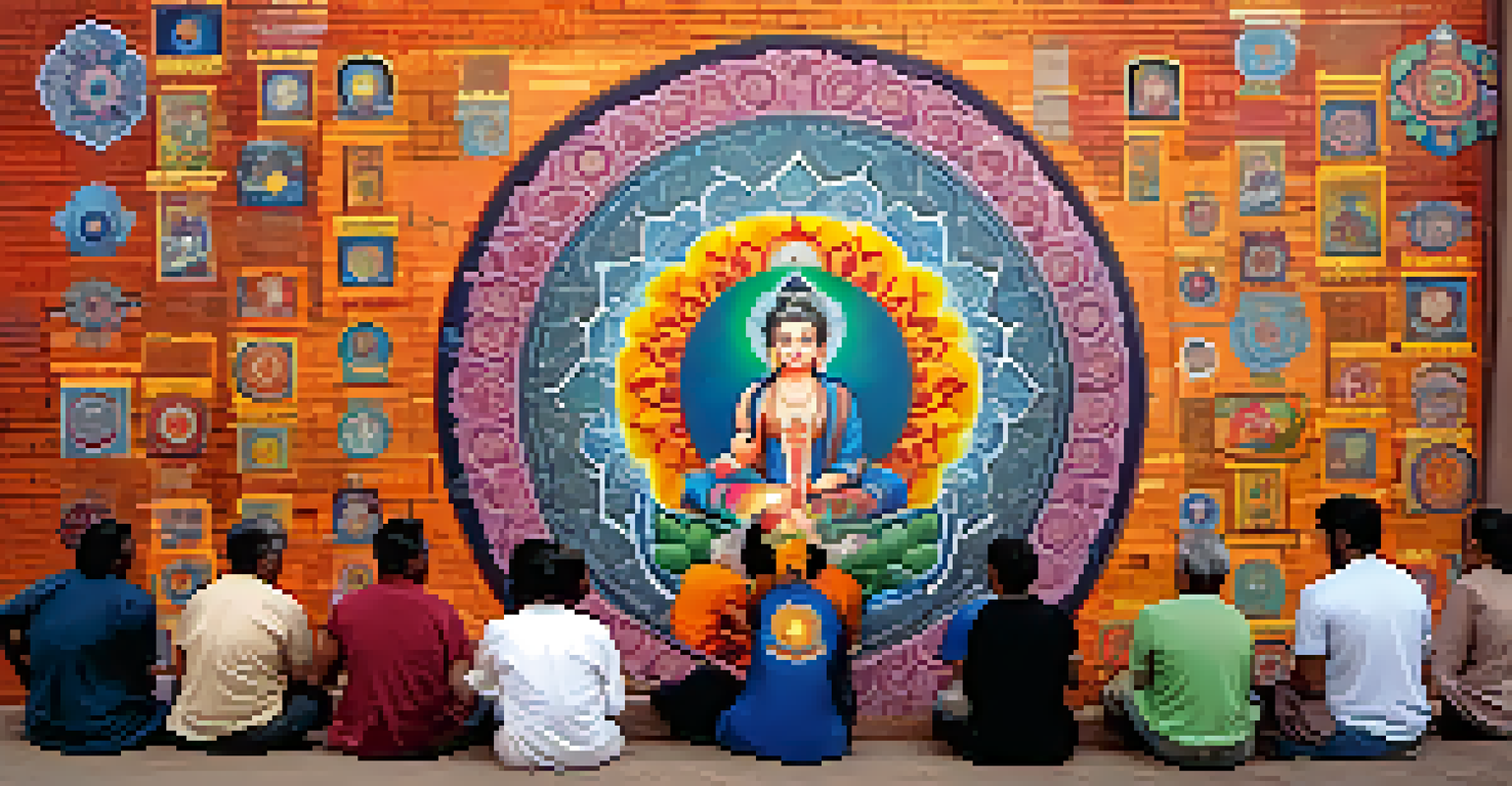The Influence of Spirituality on Language and Cultural Identity

Understanding Spirituality and Its Role in Culture
Spirituality often refers to a sense of connection to something greater than ourselves. It can encompass various beliefs, values, and practices that shape how individuals see the world. This deep-rooted aspect of humanity significantly influences cultural identity, as it creates a shared sense of belonging and purpose among individuals within a community.
Language is the road map of a culture. It tells you where its people come from and where they are going.
In many cultures, spirituality is intertwined with traditions and rituals passed down through generations. These practices often include unique language and expressions that reflect spiritual beliefs. For example, indigenous communities have specific words or phrases that convey spiritual concepts, which are vital for preserving their cultural identity.
By understanding spirituality's role in culture, we can appreciate how it shapes not only individual identities but also collective ones. This connection often manifests in artistic expressions, such as poetry and storytelling, where language becomes a vessel for spiritual exploration and cultural continuity.
The Language of Spirituality: Words That Connect Us
Language is a powerful tool that conveys not just information but also emotions and beliefs. Spirituality often enriches language by introducing terms that reflect profound experiences and concepts, such as 'soul,' 'karma,' or 'enlightenment.' These words carry significant weight and meaning, helping individuals articulate their spiritual journeys and experiences.

Moreover, the way language is used in spiritual contexts can vary widely across cultures. For instance, many religious traditions have specific prayers or chants that are integral to their practices. These phrases often possess a rhythm and melody that enhance their spiritual significance, creating a deeper connection for those who use them.
Spirituality Shapes Cultural Identity
Spirituality fosters a shared sense of belonging and purpose within communities, influencing both individual and collective identities.
Through the lens of spirituality, language becomes more than a means of communication; it transforms into a sacred practice. The choice of words and the way they are expressed can foster a sense of unity among individuals who share similar beliefs, reinforcing cultural identity.
Cultural Narratives Shaped by Spiritual Beliefs
Cultural narratives are stories that define a community's identity and values. Spiritual beliefs often serve as the backbone of these narratives, influencing how stories are told and what themes are emphasized. For instance, many cultures have creation myths or legends that integrate spiritual elements to explain their origins and place in the universe.
Art is the most beautiful of all lies; it is a bridge between the soul and the world.
These narratives often utilize symbolic language and metaphors that resonate deeply with community members. By reflecting shared spiritual beliefs, these stories help reinforce cultural identity and create a sense of continuity across generations. For example, the use of animals or natural elements in storytelling often carries spiritual significance that resonates within the culture.
As individuals engage with these narratives, they not only learn about their cultural heritage but also explore their spirituality. This interplay between stories and beliefs helps solidify a shared identity, fostering a sense of belonging and connection within the community.
The Interplay of Language and Spiritual Practices
Spiritual practices often involve specific language use that can enhance the experience and foster deeper connections. For example, many meditation practices use mantras—repeated words or phrases—that help focus the mind and connect the individual to their spirituality. This highlights how language can be a spiritual tool rather than just a means of communication.
In various religious ceremonies, the language used can carry sacred significance, often invoking a sense of reverence. The recitation of sacred texts, prayers, or hymns becomes an act of devotion that reinforces cultural identity. These practices often vary widely across different spiritual traditions, reflecting the unique cultural contexts they originate from.
Language Connects Spiritual Practices
The use of specific language in spiritual contexts enhances practices and reinforces cultural identity through shared expressions.
Ultimately, the interplay between language and spiritual practices creates a rich tapestry of cultural identity. Through the use of sacred language, individuals find ways to articulate their beliefs, connect with others, and celebrate their cultural heritage.
Influence of Globalization on Spiritual Language and Identity
Globalization has brought diverse cultures and spiritual practices into closer contact, leading to a fascinating exchange of ideas and languages. This blending can enrich spiritual vocabulary, as new terms and concepts are introduced and adopted. However, it also poses challenges in maintaining the integrity of traditional languages and spiritual practices.
For instance, as individuals explore spiritual practices from various cultures, they may adopt new terms without fully understanding their significance. This can dilute the original meanings and impact the way spiritual beliefs are expressed. It's essential to approach this blending with respect and an awareness of cultural nuances to preserve authenticity.
While globalization can create a more interconnected world, it also highlights the importance of honoring and preserving unique spiritual languages and cultural identities. By doing so, we ensure that the rich tapestry of human spirituality remains vibrant and diverse.
The Role of Art and Literature in Expressing Spiritual Identity
Art and literature serve as powerful mediums for expressing spirituality and cultural identity. Through poetry, prose, and visual art, individuals can explore and communicate their spiritual experiences in ways that resonate deeply with others. This creative expression often draws on unique language that reflects spiritual themes and cultural values.
For example, many authors and poets incorporate spiritual imagery and language into their work, creating a bridge between personal experience and collective identity. This not only enriches the literary landscape but also fosters a deeper understanding of cultural nuances and spiritual beliefs.
Globalization Impacts Spiritual Language
While globalization enriches spiritual vocabulary, it also challenges the preservation of traditional languages and cultural nuances.
Moreover, art often transcends language barriers, allowing individuals from different backgrounds to connect on a spiritual level. Through shared experiences and expressions, art and literature contribute significantly to the ongoing dialogue about spirituality and cultural identity.
Conclusion: Celebrating the Connection Between Spirituality and Identity
The intricate relationship between spirituality, language, and cultural identity is a rich field of exploration. Understanding how spirituality influences language helps us appreciate the depth and diversity of human experience. It reveals the ways in which we connect with each other and our shared beliefs.
As we celebrate this connection, we should also strive to honor the unique expressions of spirituality that exist across cultures. By fostering respect and understanding, we can create a more inclusive narrative that values the contributions of diverse spiritual traditions.

Ultimately, recognizing the influence of spirituality on language and cultural identity encourages us to embrace our shared humanity while celebrating our unique differences. This perspective enriches our understanding of ourselves and the world around us, fostering a deeper sense of connection and belonging.